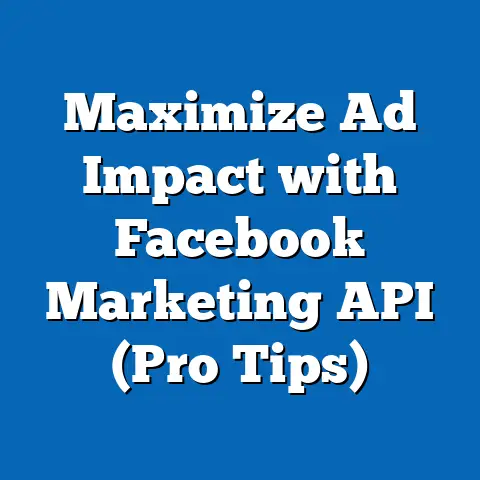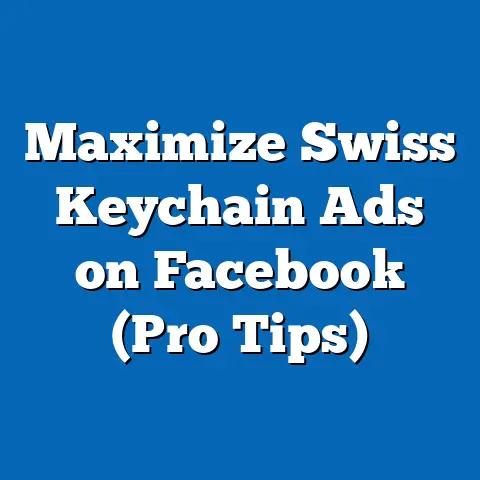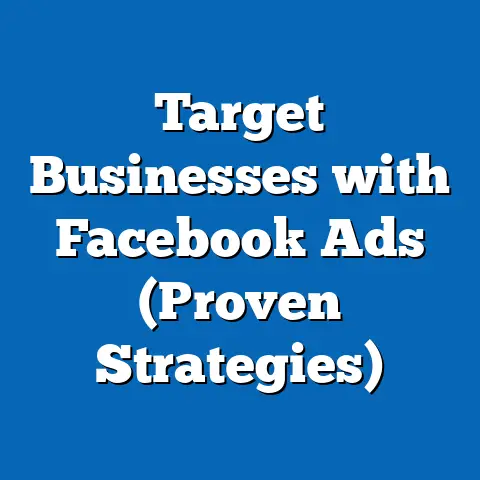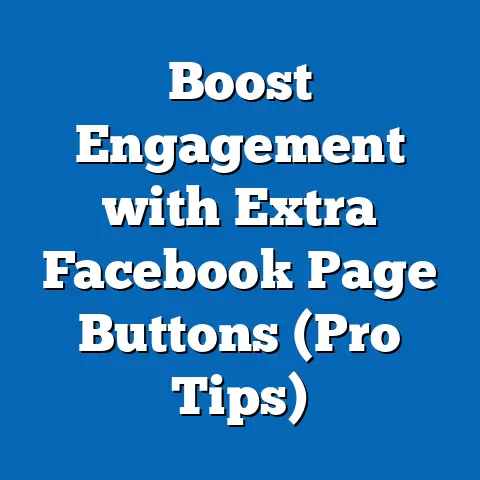Unlock Facebook Ads Hacks for 2025 (Game-Changing Strategies)
Let me tell you a story. It’s about Sarah, a small business owner who felt completely overwhelmed by the world of Facebook Ads. She started with a dream – to share her handcrafted jewelry with the world. But her initial attempts at advertising felt like throwing money into a black hole. She was lost in the complexities of targeting, ad creatives, and ever-changing algorithms.
Then, Sarah stumbled upon a new approach – one that embraced innovation, data-driven insights, and a deep understanding of her audience. She started experimenting with video ads, interactive content, and hyper-personalized messaging. And guess what? Her sales skyrocketed! Sarah’s story isn’t just a feel-good anecdote; it’s a testament to the power of staying ahead of the curve in the dynamic world of Facebook Ads. As we journey towards 2025, the need for game-changing strategies has never been greater. The digital landscape is evolving at warp speed, and what worked yesterday might be obsolete tomorrow. So, buckle up as I guide you through the essential Facebook Ads hacks that will not only keep you relevant but also propel you to the forefront of your industry!
The Evolution of Facebook Ads
To truly understand where we’re going, we need to appreciate where we’ve been. The journey of Facebook Ads is a fascinating one, marked by constant innovation and adaptation.
Historical Context
Back in the early days of Facebook, advertising was a relatively simple affair. Remember those basic sidebar ads with a picture and a short headline? Targeting options were limited, and the focus was primarily on driving traffic to websites. Over the years, however, Facebook Ads has transformed into a sophisticated advertising platform.
Here are some key milestones that have shaped its evolution:
Current Landscape (2023)
As we stand in 2023, Facebook Ads is a mature and complex ecosystem. It offers a wide array of features, tools, and analytics that empower advertisers to create highly targeted and effective campaigns.
Here are some key aspects of the current landscape:
- Advanced Targeting Options: Facebook provides granular targeting options based on demographics, interests, behaviors, and connections.
- Diverse Ad Formats: Advertisers can choose from a variety of ad formats, including image ads, video ads, carousel ads, collection ads, and lead generation ads.
- Sophisticated Analytics: Facebook Ads Manager offers robust analytics and reporting capabilities, allowing advertisers to track key metrics and optimize their campaigns.
- AI-Powered Automation: Facebook leverages artificial intelligence to automate various aspects of advertising, such as ad delivery, bidding, and audience targeting.
- Enhanced E-commerce Integration: Facebook Shops and dynamic ads make it easier for businesses to sell products directly on the platform.
However, the growing competition for ad space and the increasing complexity of the platform have made it more challenging than ever to achieve success with Facebook Ads. The need for innovative strategies, data-driven decision-making, and a deep understanding of the audience is paramount.
Takeaway: Understanding the evolution of Facebook Ads and the current landscape is essential for developing effective strategies that stand the test of time. Keep learning and adapting, and you’ll be well-equipped to navigate the ever-changing world of Facebook advertising.
Understanding the Audience
Let’s face it, you can have the most visually stunning ad in the world, but if it’s shown to the wrong people, it’s like whispering in a hurricane – completely ineffective. That’s why understanding your audience is the bedrock of any successful Facebook Ads campaign.
Audience Segmentation
Audience segmentation is the process of dividing your target market into distinct groups based on shared characteristics, such as demographics, interests, behaviors, and purchase history. By segmenting your audience, you can create highly targeted ads that resonate with specific groups of people.
Here are some advanced tools and techniques for audience segmentation on Facebook:
- Custom Audiences: These audiences are created by uploading your own customer data, such as email addresses, phone numbers, and website visitors. This allows you to target your existing customers with tailored ads. I once worked with a client who uploaded their customer email list to Facebook and created a custom audience. We then ran ads promoting a loyalty program specifically to this audience, resulting in a 30% increase in loyalty program sign-ups.
- Lookalike Audiences: These audiences are created by identifying users who share similar characteristics with your existing customers. Facebook analyzes your customer data and finds other users who are likely to be interested in your products or services. Lookalike audiences are a great way to expand your reach and acquire new customers. I’ve personally seen lookalike audiences outperform interest-based targeting in several campaigns, particularly when targeting a highly specific niche.
- Detailed Targeting: Facebook’s detailed targeting options allow you to target users based on their demographics, interests, behaviors, and connections. This is a powerful tool for reaching specific segments of your target market. For example, you can target women aged 25-34 who are interested in yoga and healthy eating.
- Website Custom Audiences: These audiences are created by tracking users who visit your website using the Facebook Pixel. This allows you to retarget users who have shown interest in your products or services but haven’t yet made a purchase. Retargeting is one of the most effective advertising strategies, as it allows you to reach users who are already familiar with your brand.
- Engagement Custom Audiences: These audiences are created by targeting users who have interacted with your Facebook or Instagram content, such as liking your posts, watching your videos, or clicking on your ads. This allows you to reach users who are already engaged with your brand.
User Behavior Trends
Understanding current user behavior trends on Facebook is crucial for informing your ad strategy. What content do users prefer? How do they engage with brands? What are their demographic characteristics?
Here are some key user behavior trends to keep in mind:
- Mobile-First Consumption: The majority of Facebook users access the platform on their mobile devices. This means that your ads should be optimized for mobile viewing. Use clear and concise copy, high-quality visuals, and mobile-friendly landing pages.
- Video Dominance: Video content is increasingly popular on Facebook. Users are more likely to engage with video ads than with image ads or text ads. Experiment with different video formats, such as short-form videos, live videos, and 360° videos.
- Authenticity and Transparency: Users are increasingly wary of advertising and are more likely to trust brands that are authentic and transparent. Be honest and upfront in your ads, and avoid making exaggerated claims.
- Personalization: Users expect brands to understand their needs and preferences. Personalize your ads based on user data, such as demographics, interests, and purchase history.
- Community Engagement: Users want to connect with brands and other users who share their interests. Foster a sense of community around your brand by creating engaging content and encouraging interaction.
Takeaway: By understanding your audience and their behavior trends, you can create highly targeted and effective Facebook Ads campaigns that resonate with your target market. Don’t just guess – use data to inform your decisions.
Creative Strategies for 2025
In the ever-evolving landscape of Facebook advertising, creativity is your superpower. As we look towards 2025, it’s clear that traditional ad formats are no longer enough to capture attention and drive results. You need to think outside the box and experiment with innovative creative strategies.
Video Content Domination
Video is king, and it’s not just a trend – it’s a fundamental shift in how people consume content online. On Facebook, video ads have consistently outperformed other formats in terms of engagement, reach, and conversion rates.
Here are some tips for creating engaging video ads:
- Tell a Story: People are drawn to stories. Use storytelling techniques to create videos that resonate with your audience on an emotional level. I remember working on a campaign for a local bakery where we created a short video showcasing the passion and dedication of the baker. The video went viral, and the bakery saw a significant increase in sales.
- Keep it Short and Sweet: Attention spans are short. Aim for videos that are 15-30 seconds long. Get to the point quickly and keep your message concise.
- Use Eye-Catching Visuals: High-quality visuals are essential for capturing attention. Use bright colors, dynamic animations, and engaging imagery.
- Optimize for Mobile Viewing: Most Facebook users watch videos on their mobile devices. Make sure your videos are optimized for mobile viewing, with clear text and a vertical aspect ratio.
- Add Captions: Many users watch videos with the sound off. Add captions to your videos to ensure that your message is understood.
- Experiment with Different Formats: Try different video formats, such as short-form videos, live videos, 360° videos, and animated videos.
Interactive and Immersive Ads
Interactive and immersive ad formats are designed to engage users in a more meaningful way. These formats allow users to interact with your ads, creating a more memorable and engaging experience.
Here are some examples of interactive ad formats:
- Poll Ads: These ads allow users to vote on a question or opinion poll. Poll ads are a great way to gather feedback and engage your audience.
- Quiz Ads: These ads allow users to take a quiz and learn something new. Quiz ads are a great way to educate your audience and generate leads.
- AR Experiences: Augmented reality (AR) experiences allow users to interact with your products in a virtual environment. AR experiences are a great way to showcase your products and drive sales. For example, a furniture retailer could create an AR experience that allows users to see how a piece of furniture would look in their home.
- Playable Ads: These ads allow users to play a mini-game or demo of your app. Playable ads are a great way to drive app installs and engagement.
These interactive ad formats can dramatically boost engagement and conversion rates.
Personalization at Scale
In 2025, personalization will be more important than ever. Users expect brands to understand their needs and preferences and to deliver personalized experiences.
Here are some ways to personalize your Facebook Ads at scale:
- Dynamic Ads: Dynamic ads allow you to automatically show the most relevant products to each user based on their browsing history and purchase behavior. This ensures that users see ads for products that they are actually interested in.
- AI-Powered Targeting: Facebook’s AI-powered targeting algorithms can help you identify the most relevant users for your ads. These algorithms analyze user data and identify patterns that indicate interest in your products or services.
- Customized Messaging: Use dynamic creative optimization (DCO) to create multiple versions of your ad copy and visuals. Facebook will then automatically show the best performing combination to each user.
- Personalized Landing Pages: Direct users to landing pages that are tailored to their specific needs and interests. This can significantly improve conversion rates.
Takeaway: Creativity is the key to standing out in the crowded world of Facebook Ads. Experiment with video content, interactive ad formats, and personalization to create engaging and effective campaigns that resonate with your audience.
Data-Driven Decision Making
Gone are the days of relying on gut feelings and intuition. In 2025, data will be the driving force behind every successful Facebook Ads campaign. To maximize your ROI, you need to embrace data-driven decision-making and leverage advanced analytics tools to optimize your strategies.
Advanced Analytics Tools
Facebook Ads Manager offers a wealth of data and insights that can help you understand your ad performance. However, to truly unlock the power of data-driven decision-making, you need to leverage advanced analytics tools.
Here are some key metrics to track in Facebook Ads Manager:
- Reach: The number of unique users who saw your ad.
- Impressions: The number of times your ad was displayed.
- Frequency: The average number of times each user saw your ad.
- Click-Through Rate (CTR): The percentage of users who clicked on your ad after seeing it.
- Cost Per Click (CPC): The average cost you paid for each click on your ad.
- Conversion Rate: The percentage of users who completed a desired action after clicking on your ad, such as making a purchase or filling out a form.
- Cost Per Acquisition (CPA): The average cost you paid for each conversion.
- Return on Ad Spend (ROAS): The amount of revenue you generated for every dollar you spent on advertising.
Beyond these basic metrics, delve into more granular data to understand user behavior. Look at metrics like:
- Video Completion Rate: How much of your video ads are people watching? Drop-off points can indicate where you’re losing attention.
- Attribution Modeling: Understand which ads are contributing to conversions across the entire customer journey.
- Demographic Breakdowns: Analyze which age groups, genders, and locations are responding best to your ads.
A/B Testing for Optimization
A/B testing, also known as split testing, is the process of comparing two versions of an ad to see which one performs better. This is a powerful tool for optimizing your ad creatives, targeting, and bidding strategies.
Here are some best practices for conducting effective A/B tests:
- Test One Variable at a Time: To get accurate results, only change one variable at a time. For example, test different headlines, images, or call-to-action buttons.
- Use a Control Group: Keep one version of your ad unchanged as a control group. This will help you measure the impact of your changes.
- Run Tests for a Sufficient Period: Allow your tests to run for a sufficient period of time to gather enough data. A good rule of thumb is to run tests for at least a week.
- Analyze Your Results: Carefully analyze your results to determine which version of your ad performed better. Use statistical significance to ensure that your results are reliable.
- Implement Your Findings: Implement your findings by using the best performing version of your ad in your campaigns.
Takeaway: Data is your most valuable asset in the world of Facebook Ads. Embrace data-driven decision-making, leverage advanced analytics tools, and conduct A/B tests to optimize your strategies and maximize your ROI.
Navigating Regulatory Changes and Privacy
The digital landscape is constantly evolving, and with it comes increasing scrutiny over data privacy. As we move closer to 2025, it’s crucial to understand the impact of privacy regulations on Facebook advertising and to build trust with your audience through transparent practices.
Understanding Privacy Regulations
Data privacy regulations, such as the General Data Protection Regulation (GDPR) in Europe and the California Consumer Privacy Act (CCPA) in the United States, have significantly impacted Facebook advertising. These regulations give users more control over their personal data and require businesses to obtain consent before collecting and using their data for advertising purposes.
Here are some ways to ensure compliance with data privacy regulations:
- Obtain Consent: Obtain explicit consent from users before collecting and using their data for advertising purposes.
- Be Transparent: Be transparent about how you collect and use user data. Provide clear and concise privacy policies that explain your data practices.
- Respect User Rights: Respect user rights, such as the right to access, correct, and delete their personal data.
- Implement Data Security Measures: Implement robust data security measures to protect user data from unauthorized access and disclosure.
- Stay Informed: Stay informed about the latest data privacy regulations and update your practices accordingly.
Building Trust with Transparency
In an era of increasing skepticism, building trust with your audience is more important than ever. Transparency is key to building trust.
Here are some ways to build trust with your audience through transparent advertising practices:
- Be Honest and Upfront: Be honest and upfront in your ads. Avoid making exaggerated claims or misleading statements.
- Disclose Sponsored Content: Clearly disclose when your content is sponsored or paid for.
- Be Responsive: Be responsive to user questions and concerns. Address any issues promptly and transparently.
- Provide Value: Provide value to your audience through your ads. Offer helpful information, entertaining content, or exclusive deals.
- Respect User Privacy: Respect user privacy and avoid collecting or using data that is not necessary for your advertising purposes.
Takeaway: Data privacy is a critical issue in the world of Facebook Ads. Ensure compliance with data privacy regulations and build trust with your audience through transparent advertising practices. This will not only protect your business from legal risks but also enhance your brand reputation and customer loyalty.
Future-Proofing Your Facebook Ad Strategy
The world of Facebook Ads is constantly changing. To stay ahead of the curve, you need to anticipate future trends and adapt your strategies accordingly.
Anticipating Changes in 2025
What will Facebook Ads look like in 2025? While it’s impossible to predict the future with certainty, we can make some educated guesses based on current trends and emerging technologies.
Here are some potential changes to watch out for:
- Increased Use of AI: Artificial intelligence will play an even greater role in Facebook advertising, automating various aspects of ad delivery, targeting, and optimization.
- Greater Emphasis on Personalization: Personalization will become even more sophisticated, with ads tailored to individual user preferences and behaviors.
- Rise of Immersive Experiences: Augmented reality (AR) and virtual reality (VR) will become more prevalent in Facebook advertising, creating immersive experiences for users.
- Focus on Privacy: Data privacy will continue to be a major concern, with stricter regulations and greater user control over their data.
- Integration with the Metaverse: Facebook’s metaverse vision will likely lead to new advertising opportunities within virtual worlds.
Community and Engagement
In the future, advertising will be less about broadcasting messages and more about building relationships. Building a community around your brand will be crucial for enhancing ad effectiveness.
Here are some strategies for fostering engagement beyond traditional advertising:
- Create a Facebook Group: Create a Facebook group where your customers can connect with each other and with your brand.
- Run Contests and Giveaways: Run contests and giveaways to engage your audience and generate excitement.
- Host Live Events: Host live events, such as webinars, Q&A sessions, and product demos, to connect with your audience in real-time.
- Encourage User-Generated Content: Encourage your customers to create and share content related to your brand.
- Be Responsive and Engaging: Be responsive to user comments and questions, and engage in conversations with your audience.
Takeaway: The future of Facebook Ads is uncertain, but one thing is clear: the need for innovation, personalization, and community building will only increase. Stay informed about emerging trends, experiment with new technologies, and focus on building meaningful relationships with your audience.
Conclusion
As we draw closer to 2025, the world of Facebook Ads will continue to evolve at a rapid pace. To succeed in this dynamic environment, you need to embrace innovative strategies, adapt to changing regulations, and focus on building meaningful relationships with your audience. By understanding the evolution of Facebook Ads, segmenting your audience, creating engaging content, leveraging data-driven insights, and building trust through transparency, you’ll be well-equipped to unlock the full potential of Facebook Ads in the coming years.
Remember Sarah, the small business owner from the beginning? She didn’t just stumble upon success. She actively sought out new knowledge, experimented with different strategies, and embraced a data-driven approach. You can do the same!
Here are some actionable steps you can take right now:
- Review Your Current Strategies: Are your current Facebook Ads strategies aligned with the latest trends and best practices?
- Experiment with New Ad Formats: Try out video ads, interactive ads, and dynamic ads.
- Improve Your Audience Targeting: Segment your audience and create highly targeted ads.
- Leverage Data Analytics: Track your ad performance and use data to optimize your campaigns.
- Stay Informed: Keep up with the latest news and trends in Facebook advertising.
The journey to mastering Facebook Ads is a continuous one. But by embracing a growth mindset, staying informed, and taking action, you can unlock the full potential of this powerful advertising platform and achieve your business goals. Go forth and conquer the world of Facebook Ads!






